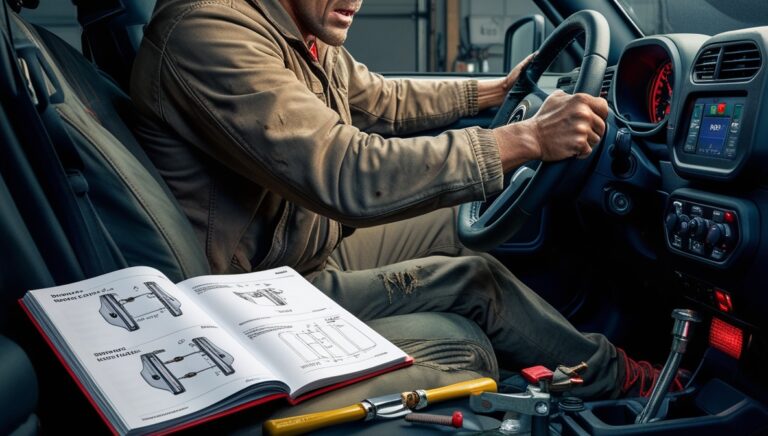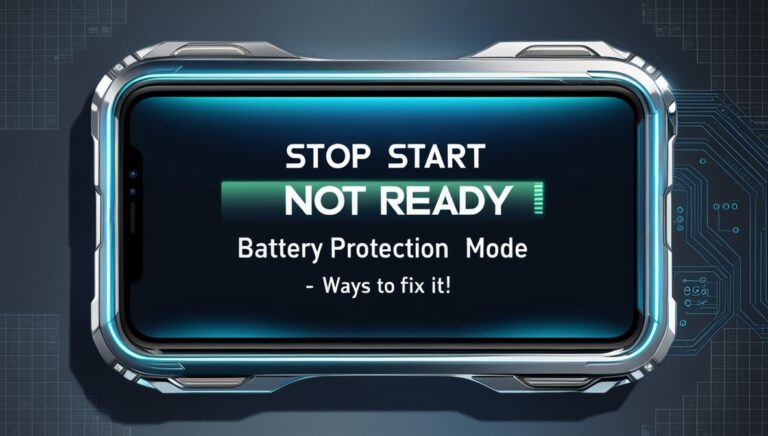Jeep Wrangler Dies While Driving But Restarts? Why Does It Happen?
Experiencing your Jeep Wrangler stalling while driving can be unsettling, but understanding why it happens and how to address it is vital for peace of mind on the road. Then why exactly, a jeep wrangler dies while driving but restarts?
According to Vehicle engine expert, behind the jeep wrangler stalling problem, 40% of the time is the fuel system issue, 30% air intake issue and 30% of the time it is the ignition system issue. Among them most common are faulty mass airflow or O2 sensor, faulty fuel injector, low fuel level and so on.
However, to fix the problem, you will need a comprehensive understanding about the matter and fixes to sort out the problem. That’s why here we’re with this detailed guide. All you just need to read on.
Key Takeaways:
- Regular maintenance is crucial to prevent Jeep Wrangler stalling; keep sensors clean and fuel quality high.
- Address issues promptly to avoid further damage and ensure safe driving.
- Practice fuel-efficient driving habits and monitor fuel levels to prevent stalling episodes.
- Stay prepared for extreme driving conditions, as they can increase the risk of engine stalling.
What Causes The Jeep Wrangler Dies While Driving But Restarts?
When your Jeep Wrangler stalls while driving, it can be worrying. But knowing why it happens and how to fix it can give you peace of mind.
Let’s explore common reasons, like sensor problems or fuel issues, and easy steps to solve them.
1# Faulty Mass Airflow Sensor (MAF)
Responsible for measuring the amount of air entering the engine, the MAF plays a critical role in determining the optimal air-fuel mixture for combustion.
When it malfunctions, either due to contamination or electrical issues, it fails to provide accurate data to the engine control unit (ECU).
Consequently, the ECU may deliver an incorrect amount of fuel, leading to an overly lean or rich mixture. This imbalance disrupts the combustion process, causing the engine to stall during operation.
How To Fix:
Here is how you can fix the problem.
- Step 1: Disconnect the MAF sensor from the intake air duct.
- Step 2: Use a specialized MAF cleaner to gently remove any dirt or debris from the sensor’s wires and elements.
- Step 3: Allow the sensor to dry completely before reinstalling it.
- Step 4: Reconnect the MAF sensor and ensure the electrical connection is secure.
- Step 5: If cleaning doesn’t resolve the issue, consider replacing the MAF sensor with a new one.
2# Faulty Oxygen Sensor
Positioned in the exhaust system, the oxygen sensor monitors the level of unburned oxygen in the exhaust gasses. This information is relayed to the ECU, which adjusts the fuel delivery accordingly to maintain the ideal air-fuel ratio.
However, if the oxygen sensor becomes faulty or contaminated with carbon deposits over time, it may provide inaccurate readings to the ECU.
As a result, the ECU may incorrectly adjust the fuel delivery, leading to an imbalanced air-fuel mixture and ultimately causing the engine to stall while driving.
How To Fix:
Follow the below steps to fix the problem.
- Step 1: Locate the faulty oxygen sensor in the exhaust system. Use an oxygen sensor socket and wrench to carefully remove the old sensor.
- Step 2: Install the new oxygen sensor, ensuring proper alignment and torque. Connect the sensor’s wiring harness securely.
- Step 3: Use a scan tool to reset the ECU and clear any stored error codes.
3# Faulty Fuel Injectors
Fuel injectors are responsible for precisely delivering fuel into the combustion chamber. When they malfunction, whether due to internal mechanical issues, clogging, or electrical faults, they may deliver an insufficient or erratic amount of fuel.
This inconsistency disrupts the combustion process, leading to misfires and engine hesitation. In severe cases, it can cause the engine to stall abruptly while driving, especially under high demand conditions such as acceleration or climbing hills.
How To Fix:
To fix the faulty fuel injector problem, check out the below steps.
- Access the fuel injectors, typically located on the fuel rail.
- Use a fuel injector cleaning kit or professional service to clean the injectors thoroughly.
- If cleaning fails, remove and replace the injectors with new ones compatible with your vehicle.
- Reassemble the fuel system, ensuring all connections are secure.
- Test the engine for proper operation and fuel delivery.
4# Bad Fuel Pump
The fuel pump is tasked with supplying a steady flow of fuel from the tank to the engine. If the fuel pump fails or becomes inefficient due to wear or electrical issues, it may not deliver an adequate amount of fuel to meet the engine’s demand.
As a result, the engine may experience fuel starvation, causing it to sputter and eventually stall, particularly during acceleration or at higher speeds.
How To Fix:
Fix the problem following the below steps.
- Step 1: Locate the fuel pump, usually inside the fuel tank. Disconnect the negative terminal of the battery to prevent electrical hazards.
- Step 2: Remove the fuel tank or access panel to reach the fuel pump assembly. Replace the fuel pump with a new one, following manufacturer instructions for installation.
- Step 3: Reconnect the battery and test the fuel pump for proper operation and fuel pressure.
5# Dirty or Faulty Sensors
Various sensors, such as the throttle position sensor (TPS) or idle air control valve (IAC), play crucial roles in regulating the engine’s air intake and fuel delivery.
Over time, these sensors can become contaminated with dirt, oil, or carbon deposits, leading to inaccurate readings or signal disruptions.
When these sensors fail to provide accurate data to the ECU, the engine may receive incorrect instructions for fuel delivery and air intake, resulting in erratic behavior and potential stalling while driving.
How To Fix:
Check out the below steps to fix the issue.
- Identify the affected sensors, such as the TPS or IAC, using a diagnostic scan tool.
- Remove the sensors from their mounting locations.
- Clean the sensors using manufacturer-approved cleaning solutions and techniques.
- If cleaning doesn’t resolve the issue, replace the sensors with new ones compatible with your vehicle.
- Reinstall the sensors and ensure proper connection and calibration.
6# Bad Crankshaft Position Sensor
The crankshaft position sensor detects the rotational speed and position of the crankshaft, allowing the ECU to synchronize fuel injection and ignition timing.
If this sensor malfunctions or becomes damaged, it can disrupt the engine’s timing, leading to misfires and potentially causing the engine to stall unexpectedly during operation.
How To Fix:
Here is how you can fix the problem.
- Step 1: Locate the crankshaft position sensor, typically near the engine’s crankshaft pulley.
- Step 2: Disconnect the sensor’s wiring harness and remove the sensor from its mounting position.
- Step 3: Install the new crankshaft position sensor, ensuring proper alignment and torque.
- Step 4: Reconnect the sensor’s wiring harness securely.
7# Faulty Alternator
The alternator is responsible for generating electrical power to charge the battery and power the vehicle’s electrical systems.
If the alternator fails or develops faults, it may not produce a consistent electrical output, leading to voltage fluctuations or insufficient power supply to essential engine components.
This can result in erratic engine behavior, including stalling, especially when the vehicle’s electrical demands exceed the alternator’s capacity.
How To Fix:
Check out the fixing steps below.
- Disconnect the negative terminal of the battery to prevent electrical accidents. Locate the alternator and remove the drive belt or accessory mounting brackets as necessary.
- Remove the faulty alternator from its mounting position. Install the new alternator, ensuring proper alignment and torque of mounting bolts.
- Reinstall drive belt or accessory brackets and reconnect the battery. Test the alternator output using a multimeter to verify proper charging voltage.
8# Low Fuel Level
While seemingly straightforward, low fuel levels can have adverse effects on the engine’s performance and reliability.
When the fuel level in the tank drops too low, the fuel pump may suck in air instead of fuel, leading to fuel starvation.
This disrupts the fuel delivery system, causing the engine to lose power and eventually stall, particularly when driving on inclines or during sudden acceleration.
Regularly monitoring and maintaining an adequate fuel level can help prevent this issue and ensure smooth engine operation.
How To Fix:
Here is how you can fix the problem.
- Step 1: Safely pull over to a designated stopping area.
- Step 2: Open the fuel filler door and refill the fuel tank with an adequate amount of fuel.
- Step 3: Avoid letting the fuel level drop too low in the future to prevent similar incidents.
- Step 4: Restart the engine and continue driving once the fuel tank is adequately filled.
Replacement Cost Of The Probable Faulty Components Of The Jeep Wrangler?
The replacement cost of the probable faulty components of the Jeep Wrangler can vary based on factors such as the specific model year, labor rates.
Moreover whether you choose OEM (Original Equipment Manufacturer) or aftermarket parts. Here are approximate cost ranges for each component.
| Jeep Wrangler Components | Estimated Cost |
| Mass Airflow Sensor (MAF) | $159 and $171 |
| Oxygen Sensor | $223 and $285 |
| Faulty Fuel Injectors | $307 and $356 |
| Bad Fuel Pump | $971 and $1,189 |
| Bad Crankshaft Position Sensor | $102 and $140 |
| Faulty Alternator | $276 |
How To Prevent The Jeep Wrangler Stalling Episodes Not To Happen In Future?
Preventing your Jeep Wrangler from stalling in the future is essential for a smooth ride. Here are simple steps to help you avoid stalling episodes:
- Keep up with routine maintenance tasks like oil changes, air filter replacements, and spark plug checks to ensure your engine runs smoothly.
- Always use high-quality fuel to prevent contaminants from clogging your fuel system and causing stalling.
- Regularly clean or replace sensors like the mass airflow sensor and oxygen sensor to maintain accurate readings and proper engine function.
- Avoid letting your fuel level drop too low to prevent fuel pump damage and ensure a consistent fuel supply to the engine.
- Avoid sudden acceleration or harsh driving, which can strain your engine and increase the risk of stalling.
- If you notice any signs of stalling or engine hesitation, address them promptly to prevent further damage and ensure safe driving.
FAQs
Here are some common questions about preventing Jeep Wrangler stalling episodes, along with brief answers to help you troubleshoot and maintain your vehicle:
How often should I check my Jeep Wrangler’s sensors?
It’s a good idea to inspect your sensors during routine maintenance, such as oil changes or tune-ups, and clean or replace them as needed.
Can using additives in my fuel prevent stalling?
While some fuel additives claim to clean fuel systems, it’s essential to use them according to manufacturer instructions. Regular use may help prevent fuel system buildup and maintain engine performance.
What should I do if my Jeep Wrangler stalls suddenly?
If your Jeep stalls while driving, safely pull over, check for any visible issues like low fuel or loose connections, and consult your owner’s manual for troubleshooting steps. If needed, seek professional assistance.
How can I improve fuel efficiency to prevent stalling?
Practice fuel-efficient driving habits, such as smooth acceleration and maintaining steady speeds. Regular maintenance, including tire checks and proper tire inflation, can also contribute to better fuel economy and engine performance.
Are there any specific driving conditions that increase the risk of stalling?
Yes, driving in extreme temperatures, such as extreme heat or cold, or driving in high altitudes, can affect engine performance and increase the risk of stalling. Proper vehicle preparation and maintenance are essential for these conditions.



